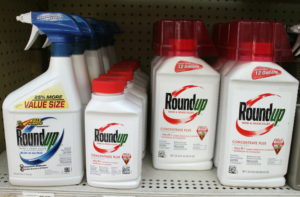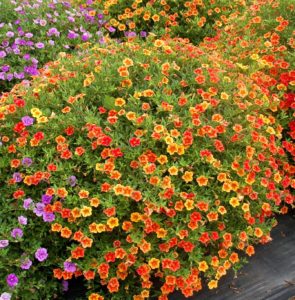This ‘n That
September 7th, 2021
Let’s catch up this week on a few gardening shorties and news tidbits you might find useful…

Roundup soon will have a different formulation — without the controversial glyphosate.
The end of Roundup as we know it
Did you hear about Bayer AG’s announcement that it plans to pull the controversial ingredient glyphosate from its Roundup weed-killer?
Roundup has been the most popular herbicide since it was introduced in the 1970s, but it’s come under fire in recent years under suspicion of causing non-Hodgkins lymphoma (a form of cancer).
While Bayer and the U.S. Environmental Protection Agency maintain that glyphosate isn’t a threat to human health or the environment, the company has been losing a string of multi-million-dollar lawsuits lately.
To limit “litigation risk,” Bayer says it’s phasing glyphosate out of the consumer version of Roundup by January 2023, meaning gardeners will have to rethink what some have used as their go-to weed-control weapon for decades.
This doesn’t mean Roundup itself will be gone.
For one thing, Bayer’s voluntary pullback doesn’t include professional and agricultural sales. That means the current glyphosate-based formulation of Roundup will still be available for licensed applicators in commercial settings and for farmers to spray on crop fields.
Second, Bayer isn’t taking the Roundup brand off the market… just changing what’s in it. No word yet on what will replace glyphosate, but Bayer has earmarked billions of dollars for research into new weed-killing agents.
If you’re not a chemical gardener in the first place, the change will have no impact (other than affecting what neighbors around you are spraying).
But if you’ve relied on Roundup, you’ll have a few decisions to make, i.e. switching to other sprays that continue to include glyphosate, trying the new Roundup formula to see how well it works, or switching gears to fight weeds in other ways.
If you need weed-fighting help, check out my 2015 post on “Winning the Weed War.”
Where does your rainfall go?
Gardeners tend to be way more concerned about getting enough rain than what happens to rain after it leaves our yards.
If you’ve ever wondered where your runoff goes, Pittsburgh web developer Sam Learner has developed a free online tool that creates a customized video of the course rain takes from your yard the whole way to the bay or ocean.
It’s called River Runner, and the software gives you this interesting video just seconds after you type in your address. It also names each body of water the rain traverses and gives distances traveled through each.
The information is useful in raising awareness about how sediment, pesticides, and other pollutants make their way into waterways.
Help with plant homework
Like anything else, the more you know and learn about plants, the more success you’ll have growing them. Especially important is getting the right plants in the right spot and allowing enough space for ideal growth.
If you need some plant-selection help with your fall planting projects, there’s an archive of hundreds of the best specific plants for Pennsylvania gardens in the Plant Profiles section of my website. It’s free to use.
I can also recommend three other free online resources that are treasure troves of detailed information on just about any landscape plant worth growing. Check out these sites for your plant research:
Longwood Gardens’ Plant Explorer
Missouri Botanical Garden’s Plant Finder
National Gardening Association’s Plants Database
Finally, my 19-page “Survivor Plants of Pennsylvania” booklet gives details on hundreds of what I think are the best specific plants and varieties for Pennsylvania yards, arranged by plant type. The booklet is updated with 2021 plants and available as a $5.95 download in the Buy Helpful Info section of my site.

Calibrachoa does better in acidic soil.
The secret to better calibrachoa
Calibrachoa is an attractive annual flower that looks a lot like a petunia with slightly smaller leaves and petals. Some of the showiest come in bright shades of gold and orange – colors not typically found in petunias.
But calibrachoa (sometimes called “million bells”) don’t have the greatest track record in the ground. I’ve found they do much better in pots and hanging baskets.
I talked to Sinclair Adam, the director of Penn State’s Trial Gardens in Lancaster County, about that this summer, and he tells me the “secret” is that calibrachoa likes acidic soil.
He says the fastest/cheapest way for a homeowner to get good results is to add a tablespoon of vinegar to a gallon of water and use that when watering calibrachoa.
Get those bulbs ASAP
While it’s still a little early to actually plant spring bulbs, you might want to buy and/or order your bulbs soon. As with seeds and plants the past two years, I’m hearing that demand is strong and early, meaning the varieties you really want might not be around later if you dawdle.
“We’ve never seen interest this high,” says Tim Schipper, founder of the Connecticut-based Colorblends bulb company.“Orders started early and are building at a strong clip.”
Just about all products related to gardening have been in high demand (and sometimes short supply) since Covid-19 fueled a boom in the at-home hobby in spring 2020.
October into early November is prime time to plant spring bulbs, such as tulips, daffodils, hyacinths, and crocuses.
Retailers have their peak supplies this month, while mail-order vendors are taking orders now to ship at the appropriate planting time.
I’ve been happy with the three catalog bulb suppliers I’ve used for years: the Connecticut-based Van Engelen Inc., the Virginia-based Brent and Becky’s Bulbs, and Colorblends.







